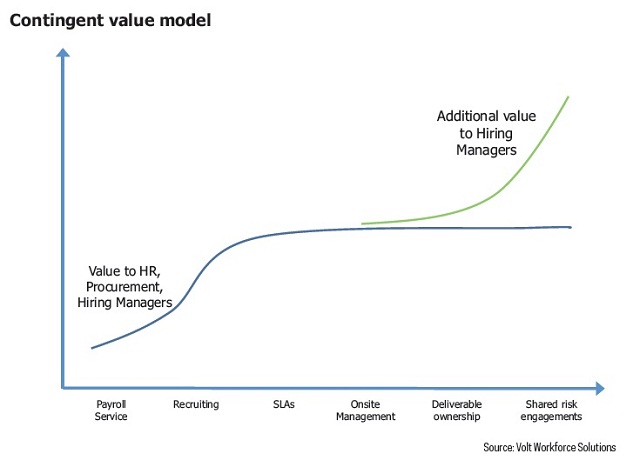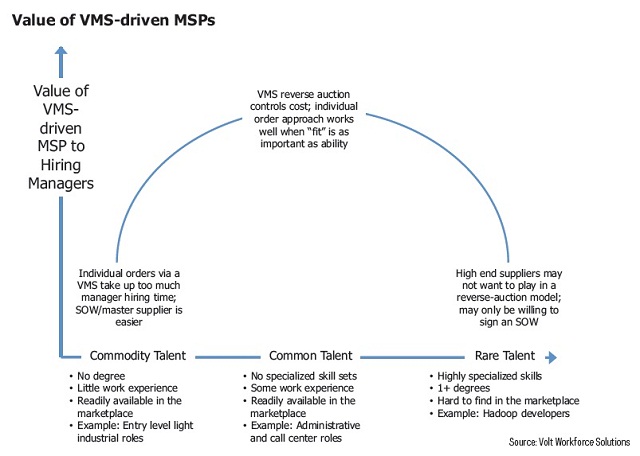But in spite of the proliferation of SOWs, this work arrangement is underutlilized.
I’ve enjoyed watching the rise of technology-driven managed service programs (MSPs). As a consumer who’s benefited from the transparency and choice our modern economy affords, the concept of reverse auctions often utilized by MSPs appeals to me. But if sellers of services can find a way to bypass the reverse auction process, they will. Staffing firms often cite the end client’s dissatisfaction with vendor management system-driven MSPs as a legitimate motivation to circumvent the system. And many are using statement-of-work (SOW) contracts to do so.
While sometimes true deliverable-based engagements, these arrangements are often time-and materials contracts with as few as one person and no expectation beyond delivering an engaged, effective professional. Over the past several years, I’ve watched some in the staffing industry move from “VMS and MSP are the future” to “SOW is our only hope.” The staffing industry is known for its aggressive sales approach; are SOW engagements simply the next thing MSPs need to get under control? Or is there real value in the SOW? Here’s a look at the opportunity that exists for the industry.
The Right Approach
Let’s begin with whether there is a “right” way for staffing firms to use SOW engagements. This is definitely a topic about which reasonable minds can disagree. Sales in the staffing industry is understandably focused on forward progress. When the need for talent is identified, the salesperson is hard pressed by often daily goals to find a way — sometimes any way — to close the deal, and if a quickly signed SOW that circumvents the MSP gets it done, so be it.
Setting aside the fact that many staffing firms are using SOWs any chance they get, I actually believe SOW structures are underutilized. Many clients use staff augmentation approaches when a more structured engagement makes sense simply because it’s the path of least resistance, or because their firm has rules where any contingent staff must go through the MSP — and be treated like a time and materials staff augmentation engagement.
Many in the staffing industry assert that the interests of hiring managers, HR and Procurement are not aligned, and we get to sort out the mess. I disagree to a point. Payroll services, pure recruiting, and even service level agreements (SLAs) within VMS-driven MSPs bring value to all three parties via the talent itself, cost controls, process management, and objective measurement.
At that point, however, things change. When the engagement goes beyond pure talent, the value for hiring managers increases (e.g., via commitment to deliverables such as QAed code) but levels off for HR and procurement (see accompanying chart). In fact HR and procurement professionals are suspicious of more complex engagements because they no longer control them (a common staffing industry perspective) or because they’re so used to staffing firms circumventing sensible controls (a fair complaint).
The SOW Paradigm
Staffing Industry Analysts believes the SOW opportunity is three times that of the contingent market. While that speaks to the opportunity with SOW, my personal experience is the driver of opportunity is that operating leaders at my clients are looking to get something off their plate — not another project to manage. When I’m stressed, I personally like going out to eat more than finding awesome ingredients at my local farmer’s market.
What’s the role of MSPs? More complex talent engagements aren’t a fit for most VMS-driven MSPs, and even those that support SOW management can struggle to address the core issue — truly understanding what the end client needs. This is why consultancies can sometimes win SOW work that is, in fact, staff augmentation. They’re set up to understand the client’s true business need, they address it, and the end-client sells it internally.
Are staffing firms missing the boat? Maybe. In the staffing industry, the decision maker is too often thought of as only the immediate hiring manager rather than a product manager or a business line manager. Staffing firms can forget that the only reason talent is engaged in the first place is to get something done — when the goal is clearly understood, the right model becomes much easier to build. If a staffing firm wants to “stick to its knitting” and only talk about talent, especially in the context of individual assignments, then the engagement structures shouldn’t be sold as anything other than time and materials staff augmentation.
If, however, a more complex project with more responsibility is the real need, that’s the time for an SOW. The answer is in the acronym; it’s about the work.
The Right Fit
If there’s a time and a place for SOW engagements versus VMS-driven MSPs, how are clients supposed to make the best choice? There are many ways to approach the issue; one I’ve found useful is to map talent types to the value these systems create for the end user, the hiring manager (see chart).
For truly commoditized talent (minimal education and work experience, often light industrial, often needed in large numbers), I’ve seen clients most successful with a master vendor model rather than a VMS-driven MSP. In the former, the client has engaged one, accountable supplier and clearly limited their function to, for example, staffing a wafer fab operation. The supplier owns pipelining of talent, quality, demand management and issue resolution. The advantage for the client is simplicity: If this were managed through a VMS driven MSP, hiring managers can get bogged down in the candidate review process and caught up in HR issues about which they have little knowledge. Here, a well-structured SOW (actually an SOS or statement of services) can also work well.
At the next rung of talent, which I’ll call common talent (some work experience but not specialized, often administrative or call center in small numbers), a VMS-driven MSP can work very well. Because these roles are engaged in a variety of tasks and customer service orientation is key to success, client interviews are often a good idea to identify the sometimes elusive “fit.” Here, the system simplifies and streamlines the candidate production and interview process, controlling pricing and often (via a markup model) ensuring fair candidate pay. Managers have the level of involvement to feel comfortable about the recruitment but the MSP manages the process steps.
In the case of rare talent (one or more degrees, significant work experience, often highly specialized), the VMS-driven MSP can encounter challenges. While the need for hiring manager assessment is even more important than with common talent, the requirements (both technical and “soft”) can be difficult to convey in the system. Despite the best efforts of the MSP team, staffing suppliers often encounter the “frag” or one sentence job description, or the “laundry list” of every possible requirement. Tradeoffs are crucial to these searches, and most systems don’t have a way to highlight them for suppliers. Search and hiring time goes up, and even with supplier/manager conference calls the potential savings via the reverse auction can pale when compared to delays to the project. In these cases, SOW structures can make sense via direct manager engagement with a group of preferred (vetted) suppliers that the manager can engage at his or her discretion.
What Next?
This is an exciting time in talent. The human cloud is rapidly growing and more than creeping into staffing territory. At the same time, consulting houses are feeling pressure for what can amount to high-markup single professional engagements. Clients are adapting in a variety of ways, ranging from locking down all contingent assignments and treating them as identical commodities (from software architect to cafeteria worker) to building complex “decision tree” models. I’ve seen one client lay out five ways to engage with them, and staffing firms, consultancies and outsourcers of all types are trying to figure it out.
Ultimately, this leads to the somewhat existential issue about what staffing firms truly are and where they should play. For many, the fast-response VMS-fueled MSP is a great fit. For others, a smaller client retail sale may work best. For still others, the SOW option maybe the right one to explore. But using it to circumvent the system may not be the smart way to go, less due to the risk of being called out, but more because the true SOW opportunity is much more attractive.









